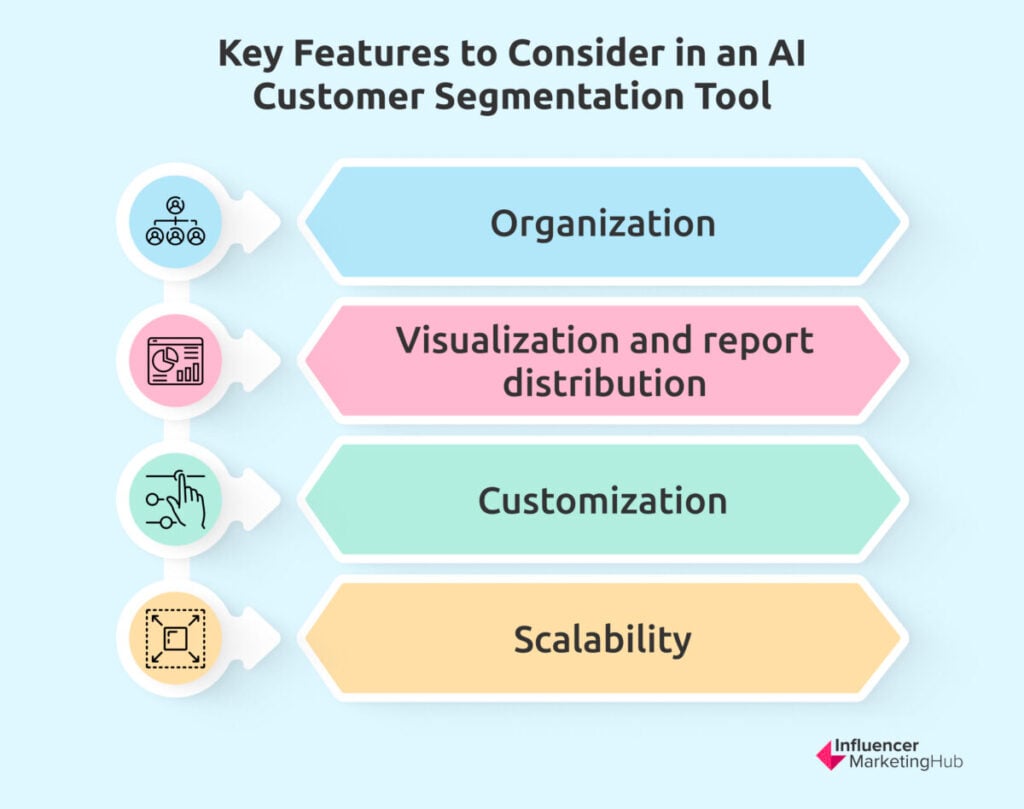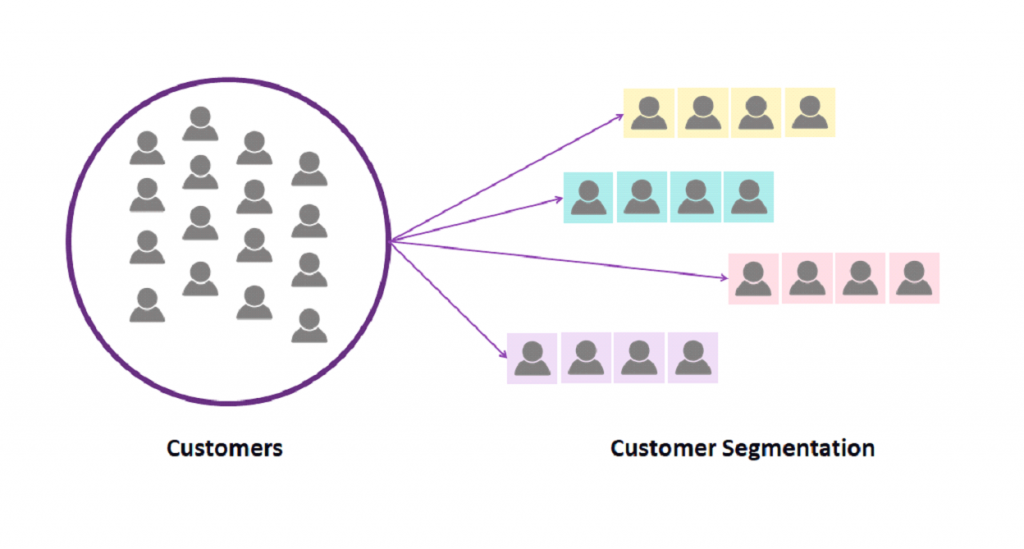AI-powered customer segmentation revolutionizes how businesses understand and interact with their clientele. This approach leverages artificial intelligence algorithms to analyze vast datasets, identifying intricate patterns and creating highly targeted customer groups. Unlike traditional methods reliant on manual rules, AI offers unparalleled precision and scalability, enabling businesses to personalize marketing campaigns, improve customer retention, and ultimately boost profitability. This exploration delves into the intricacies of AI-powered segmentation, from data preparation and model selection to ethical considerations and future trends.
We will examine various AI algorithms, such as clustering and classification, and their practical applications across diverse industries. We’ll also discuss the crucial aspects of data preparation, model training, and result interpretation, providing a holistic understanding of this powerful technique. Finally, we’ll address the ethical implications and future possibilities of AI in customer segmentation, ensuring a responsible and effective implementation.
Defining AI-Powered Customer Segmentation

AI-powered customer segmentation represents a significant advancement over traditional methods, leveraging the power of artificial intelligence to analyze vast datasets and identify intricate customer patterns that would be impossible to detect manually. This allows businesses to create more precise and effective marketing strategies, ultimately boosting customer engagement and profitability. The core difference lies in the analytical capabilities; AI utilizes sophisticated algorithms to uncover hidden relationships and segment customers based on multifaceted characteristics, whereas traditional methods often rely on simpler, rule-based approaches.AI-powered customer segmentation uses machine learning algorithms to analyze diverse customer data, such as demographics, purchase history, website behavior, and social media activity, to group customers with similar traits and behaviors.
This enables businesses to tailor their offerings and communications to specific segments, resulting in higher conversion rates and improved customer lifetime value. Unlike traditional segmentation, which may rely on pre-defined rules or limited data points, AI algorithms can dynamically adapt and learn from new data, continuously refining the segmentation process for greater accuracy and relevance.
AI Algorithms Used in Customer Segmentation
Several AI algorithms are instrumental in customer segmentation. Clustering algorithms, such as K-means and hierarchical clustering, group customers based on similarity in their characteristics without pre-defined categories. Classification algorithms, like logistic regression and support vector machines (SVMs), assign customers to predefined segments based on learned patterns from historical data. Neural networks, particularly deep learning models, can handle complex, high-dimensional data, revealing intricate relationships between customer attributes and behaviors that other methods might miss.
The choice of algorithm depends on the specific business needs, data characteristics, and desired level of granularity in segmentation.
Real-World Applications of AI-Powered Customer Segmentation
AI-powered customer segmentation finds extensive application across various industries. In e-commerce, it helps personalize recommendations, target marketing campaigns, and optimize pricing strategies. For example, an online retailer might segment customers based on their browsing history and purchase behavior to recommend relevant products and offer personalized discounts. In the financial services sector, it assists in risk assessment, fraud detection, and personalized financial advice.
Banks might use AI to segment customers based on their financial behavior to offer tailored investment products or credit lines. In healthcare, it enables personalized treatment plans and targeted interventions. Hospitals could segment patients based on their medical history and lifestyle to deliver customized care and preventative health recommendations.
Comparison of AI-Powered and Rule-Based Segmentation
| Feature | AI-Powered Segmentation | Rule-Based Segmentation |
|---|---|---|
| Data Handling | Handles large, complex datasets; identifies non-linear relationships. | Limited to smaller datasets and simpler relationships; requires manual rule definition. |
| Accuracy | Higher accuracy due to pattern recognition and adaptive learning. | Lower accuracy; prone to errors due to oversimplification and manual rule limitations. |
| Scalability | Highly scalable; adapts to growing data volumes and evolving customer behaviors. | Limited scalability; manual rule adjustments become cumbersome with increasing data. |
| Maintenance | Requires less manual intervention; self-adjusts with new data. | Requires continuous manual updates and adjustments to rules. |
Data Requirements and Preparation
Effective AI-powered customer segmentation hinges on the quality and comprehensiveness of the data used. The process begins not with the algorithms, but with a meticulous understanding of what data is needed and how it should be prepared for optimal performance. This involves identifying key data points, cleaning and preprocessing the data, and addressing issues like missing values and outliers.
The success of AI-powered customer segmentation relies heavily on the quality and relevance of the input data. Insufficient or poorly prepared data will lead to inaccurate and unreliable segments, hindering the ability to effectively target marketing campaigns or personalize customer experiences. Therefore, a robust data preparation strategy is crucial.
Key Data Points for Effective Segmentation
A comprehensive dataset is essential for robust customer segmentation. This dataset should include a variety of data points that offer a holistic view of each customer. These can be broadly categorized into demographic, behavioral, and transactional data. Demographic data includes information like age, gender, location, and income level. Behavioral data captures customer interactions, such as website visits, product views, and purchase history.
Transactional data focuses on the monetary aspects of the customer relationship, including purchase amounts, frequency, and recency. Including psychographic data, such as lifestyle preferences and values, where available, can further enhance segmentation accuracy. The specific data points will vary depending on the business and its goals. For example, an e-commerce business might prioritize transactional and behavioral data, while a subscription service might focus on engagement metrics and customer lifetime value.
Data Cleaning and Preprocessing for AI Algorithms
Data cleaning is the process of identifying and correcting or removing inaccurate, incomplete, irrelevant, duplicated, or improperly formatted data. This stage is crucial for ensuring the accuracy and reliability of the segmentation process. Preprocessing involves transforming the data into a format suitable for AI algorithms. This often includes tasks like data transformation (e.g., scaling, normalization), feature engineering (e.g., creating new variables from existing ones), and handling categorical variables (e.g., one-hot encoding).
For instance, raw numerical data might need to be standardized to a specific range to prevent features with larger values from dominating the model. Categorical variables, such as customer location, might need to be converted into numerical representations using techniques like one-hot encoding.
Handling Missing Data and Outliers in Customer Datasets
Missing data and outliers are common challenges in customer datasets. Missing data can be handled through various techniques, including imputation (filling in missing values based on other data points) or removal of incomplete records. The choice of method depends on the extent and nature of the missing data. Outliers, which are data points that significantly deviate from the norm, can skew the results of AI algorithms.
They can be handled by removing them, transforming them (e.g., using logarithmic transformation), or using robust algorithms less sensitive to outliers. For example, if a customer has an unusually high purchase value compared to others, it might be investigated for data errors or treated as a separate segment. The decision of how to treat outliers should be made based on the specific context and the potential impact on the analysis.
Workflow Diagram for Data Preparation
The data preparation process can be visualized as a workflow:
The diagram would show a flowchart beginning with “Raw Customer Data.” Arrows would then lead to “Data Cleaning” (including steps like handling missing values, identifying and correcting errors, and removing duplicates). Following this, the flow would proceed to “Data Preprocessing,” which includes steps such as data transformation (normalization, standardization), feature engineering (creating new variables), and encoding categorical variables.
The final step would be “Prepared Data for AI Algorithms,” ready for model training and customer segmentation. Each step would have sub-steps illustrating the specific techniques used (e.g., imputation methods for missing data, specific transformation methods, etc.).
AI Model Selection and Training: AI-powered Customer Segmentation

Selecting the right AI model for customer segmentation is crucial for achieving accurate and actionable insights. The choice depends on several factors, including the size and nature of the dataset, the desired level of detail in the segmentation, and the computational resources available. Different algorithms offer varying strengths and weaknesses, making careful consideration essential for optimal results.The process involves evaluating various machine learning algorithms, training them on the prepared data, and rigorously validating their performance to ensure they meet the specific needs of the business.
Optimizing model performance involves fine-tuning parameters and employing appropriate evaluation metrics.
Factors Influencing AI Model Choice, AI-powered customer segmentation
Several key factors guide the selection of an appropriate AI model. The dimensionality of the data (number of features) significantly impacts algorithm choice. High-dimensional data might necessitate dimensionality reduction techniques before applying certain algorithms. The size of the dataset influences computational complexity; some algorithms scale better than others with large datasets. The desired level of interpretability also plays a role; some models are more easily interpretable than others, which can be critical for understanding the basis of the segmentation.
Finally, the type of segmentation desired (e.g., hierarchical vs. flat) also dictates the appropriate algorithm. For instance, hierarchical clustering might be preferred when seeking a nested structure of customer segments.
Comparison of Machine Learning Algorithms
Several machine learning algorithms are suitable for customer segmentation. K-means clustering is a popular choice due to its simplicity and efficiency. It partitions data into k clusters, aiming to minimize the within-cluster variance. However, K-means requires specifying the number of clusters beforehand and is sensitive to initial cluster centers. DBSCAN (Density-Based Spatial Clustering of Applications with Noise) is another clustering algorithm that identifies clusters based on data point density.
Unlike K-means, DBSCAN doesn’t require specifying the number of clusters and can identify clusters of arbitrary shapes. However, it can be sensitive to parameter tuning (epsilon and minimum points). Support Vector Machines (SVMs), while typically used for classification, can be adapted for segmentation through techniques like one-class SVM, which identifies outliers or unusual customer profiles. However, SVMs can be computationally expensive for large datasets.
AI Model Training and Validation
Training an AI model for customer segmentation involves feeding the prepared data to the chosen algorithm. This process learns patterns and relationships within the data to create distinct customer segments. The training process often involves iterative adjustments of model parameters to optimize performance. Validation is crucial to ensure the model generalizes well to unseen data. This typically involves splitting the data into training and testing sets.
The model is trained on the training set and evaluated on the testing set to assess its performance on new, unseen data. Common evaluation metrics include silhouette score (for clustering algorithms) and accuracy (for classification-based approaches). Cross-validation techniques, such as k-fold cross-validation, can further enhance the robustness of the validation process.
Optimizing AI Model Performance
Optimizing model performance is an iterative process. Hyperparameter tuning involves adjusting the parameters of the chosen algorithm to improve its accuracy and efficiency. Techniques like grid search or randomized search can be employed to find the optimal hyperparameter settings. Feature engineering, which involves creating new features from existing ones, can significantly improve model performance. For example, combining multiple demographic features into a single “lifestyle” score can provide a more informative representation of customers.
Dealing with imbalanced datasets, where some customer segments are significantly smaller than others, requires techniques like oversampling or undersampling to prevent the model from being biased towards the larger segments. Regularization techniques can help prevent overfitting, where the model performs well on the training data but poorly on unseen data. Finally, monitoring model performance over time and retraining the model periodically with updated data ensures the segmentation remains relevant and accurate.
Interpreting and Utilizing Segmentation Results

Understanding the output of your AI-powered customer segmentation model is crucial for leveraging its potential. The model will likely group your customers into distinct segments based on shared characteristics identified during the training process. The key is to interpret these groupings meaningfully, translating the technical output into actionable marketing strategies. This involves analyzing the defining attributes of each segment and understanding their implications for your business.
Segment Attribute Analysis
The output of the AI model will typically include a description of each segment, detailing the key characteristics that define its members. This might include demographic information (age, location, income), behavioral data (purchase history, website activity, engagement with marketing campaigns), or psychographic data (lifestyle, values, interests). For example, one segment might be characterized by high income, frequent purchases of premium products, and a preference for personalized communication.
Another might be identified by lower income, infrequent purchases of budget-friendly products, and a reliance on promotional offers. Carefully analyzing these attributes allows you to create a detailed profile of each segment, providing a clear understanding of their needs and preferences.
Visualizing Customer Segments
Effective visualization is key to understanding and communicating the results of your segmentation. A well-chosen visualization makes complex data easier to grasp and can reveal hidden patterns.
Several visualization techniques can effectively illustrate customer segments:
- Scatter Plots: A scatter plot can visualize the relationship between two key variables, such as spending and frequency of purchase. Each point represents a customer, and the clustering of points reveals distinct segments. For example, a segment of high-spending, frequent buyers would appear clustered in one area of the plot, distinct from a segment of low-spending, infrequent buyers clustered elsewhere.
- Bar Charts: Bar charts are useful for comparing the characteristics of different segments. For example, you could use a bar chart to compare the average age, income, or purchase value across different segments. This provides a quick visual comparison of the key differences between groups.
- Heatmaps: Heatmaps can visually represent the strength of relationships between different variables within each segment. For example, a heatmap could show the correlation between age, income, and product preference within each segment, highlighting important relationships that might not be apparent otherwise.
- Network Graphs: These can be used to illustrate the relationships between customers within a segment, revealing potential influencers or community leaders. For example, a network graph could visualize the connections between customers who frequently interact or share similar purchase patterns.
Actionable Insights from Customer Segments
Once you have a clear understanding of your customer segments, you can begin to derive actionable insights. This involves identifying opportunities to improve customer engagement, increase sales, and enhance customer loyalty. For example, understanding that a particular segment responds well to personalized email marketing campaigns could lead to a targeted campaign focused on providing customized offers and recommendations.
Similarly, discovering that another segment is highly price-sensitive could lead to the development of budget-friendly product offerings or promotional discounts.
Marketing Strategy Design
The insights gained from customer segmentation can directly inform your marketing strategy. A tailored approach, focusing on the specific needs and preferences of each segment, will be significantly more effective than a generic, one-size-fits-all strategy. For instance, a segment of high-value customers might receive personalized recommendations and exclusive offers, while a segment of price-sensitive customers might be targeted with discounts and promotional deals.
This targeted approach improves the return on investment of your marketing efforts by ensuring that your message resonates with the intended audience. For example, a luxury car brand might target a high-income segment with sophisticated advertising campaigns emphasizing exclusivity and prestige, while a budget-friendly car brand might focus on practicality and value in its marketing to a lower-income segment.
Ethical Considerations and Challenges
AI-powered customer segmentation, while offering significant advantages, presents several ethical concerns and practical challenges that must be carefully addressed. The potential for bias, privacy violations, and misuse necessitates a responsible and thoughtful approach to its implementation and ongoing management. Failing to address these issues can lead to reputational damage, legal repercussions, and erosion of customer trust.The inherent complexities of AI models, coupled with the sensitive nature of customer data, demand a proactive strategy for mitigating risks and ensuring ethical compliance.
This includes not only the technical aspects of model development and deployment but also the organizational culture and policies that govern the use of this powerful technology.
Bias in AI-Powered Customer Segmentation
Algorithmic bias, a significant concern in AI, can manifest in customer segmentation models. This bias can stem from the training data itself, reflecting existing societal prejudices or inaccuracies in the data collection process. For example, if historical sales data shows a disproportionate number of high-value customers from a specific demographic, the model might unfairly prioritize that demographic in future segmentation, potentially excluding other equally valuable customer segments.
This can lead to discriminatory practices and reinforce existing inequalities. Understanding the sources of bias is crucial for developing effective mitigation strategies.
Privacy Concerns in Customer Segmentation
The use of personal data in customer segmentation raises significant privacy concerns. AI models often require access to vast amounts of sensitive information, including demographic details, purchase history, browsing behavior, and even social media activity. The aggregation and analysis of this data can potentially expose individuals to risks of profiling, discrimination, and even identity theft. Compliance with data protection regulations, such as GDPR and CCPA, is paramount, requiring robust data governance frameworks and transparent data handling practices.
Challenges in Implementing and Maintaining AI-Powered Segmentation Systems
Implementing and maintaining AI-powered segmentation systems present several challenges. These include the need for specialized expertise in data science, AI model development, and ethical considerations. The ongoing need for data quality control, model retraining, and system updates requires significant investment in both human resources and technological infrastructure. Furthermore, the dynamic nature of customer behavior necessitates continuous model adaptation to maintain accuracy and relevance.
The lack of transparency in some AI models can also hinder the ability to understand and explain segmentation decisions, raising concerns about accountability and fairness.
Strategies for Mitigating Bias in AI-Powered Customer Segmentation Models
Mitigating bias requires a multi-faceted approach. This includes careful curation and pre-processing of training data to identify and address existing biases. Techniques like data augmentation, resampling, and algorithmic adjustments can help to create more balanced and representative datasets. Regular audits of model performance and ongoing monitoring for signs of bias are essential. Furthermore, employing explainable AI (XAI) techniques can enhance transparency and allow for a better understanding of model decision-making processes, thereby facilitating the identification and correction of biased outputs.
Human oversight and ethical review processes are also crucial components of a comprehensive bias mitigation strategy.
Best Practices for Ensuring Responsible Use of AI in Customer Segmentation
To ensure the responsible use of AI in customer segmentation, organizations should adopt several best practices:
- Establish clear ethical guidelines and principles for the use of AI in customer segmentation.
- Implement robust data governance frameworks to ensure data privacy and security.
- Regularly audit AI models for bias and fairness.
- Employ explainable AI (XAI) techniques to enhance transparency and accountability.
- Provide customers with control over their data and the use of their information.
- Invest in training and education for employees on ethical AI practices.
- Establish mechanisms for redress and complaint handling related to AI-driven decisions.
- Foster collaboration and knowledge sharing with other organizations and stakeholders on ethical AI practices.
Future Trends and Developments
AI-powered customer segmentation is a rapidly evolving field, constantly shaped by advancements in machine learning, data science, and computing power. The future holds exciting possibilities for even more precise, personalized, and efficient customer understanding, leading to significant improvements in customer relationship management (CRM) strategies.The convergence of various AI technologies will continue to refine customer segmentation practices. We can expect more sophisticated algorithms, capable of handling increasingly complex datasets and identifying nuanced customer behaviors that were previously undetectable.
This will lead to more granular and accurate segmentation, allowing businesses to tailor their offerings and communications with unprecedented precision.
AI-Driven Personalization at Scale
The integration of AI-powered customer segmentation with other CRM tools will lead to hyper-personalization at scale. Imagine a scenario where a clothing retailer uses AI to segment customers based on purchasing history, browsing behavior, and social media activity. This segmentation allows them to not only target specific product recommendations but also to personalize the entire customer journey, from website design to email marketing, resulting in higher conversion rates and increased customer loyalty.
For example, a customer interested in sustainable fashion would receive targeted emails showcasing eco-friendly products and promotions, while a customer focused on fast fashion would see different offers entirely. This level of personalization is only achievable through sophisticated AI-powered segmentation.
Predictive Analytics and Customer Lifetime Value
AI will play a crucial role in predicting customer lifetime value (CLTV) with greater accuracy. By analyzing historical data, combined with real-time behavioral insights, AI algorithms can forecast future revenue streams associated with individual customers or customer segments. This allows businesses to optimize resource allocation, focusing on high-CLTV segments and developing tailored retention strategies to maximize profitability. For instance, a subscription service might identify a segment of users at risk of churning and proactively offer incentives or personalized support to retain them.
Explainable AI (XAI) and Transparency
The increasing demand for transparency and accountability in AI applications will drive the development of explainable AI (XAI) techniques in customer segmentation. XAI aims to make the decision-making processes of AI algorithms more understandable and interpretable, allowing businesses to gain insights intowhy* specific customers are assigned to particular segments. This enhances trust and allows for better validation and refinement of the segmentation models.
For example, XAI can help identify biases in the data or the algorithm, ensuring fair and equitable segmentation practices.
Timeline of Significant Milestones
A timeline illustrating key advancements in AI-powered customer segmentation could include:
- Early 2000s: Rudimentary customer segmentation using basic rule-based systems and early machine learning algorithms.
- Mid-2010s: Emergence of more sophisticated machine learning techniques (e.g., clustering, classification) for customer segmentation, driven by increased data availability and computing power.
- Late 2010s – Present: Widespread adoption of deep learning and neural networks for more accurate and nuanced customer segmentation, alongside the rise of cloud-based AI platforms.
- Near Future (Next 5-10 years): Increased integration of XAI, real-time behavioral analysis, and predictive modeling for hyper-personalization and improved customer lifetime value prediction.
AI-powered customer segmentation offers a transformative approach to understanding customer behavior, enabling businesses to create highly personalized experiences and optimize their marketing strategies. By leveraging the power of AI algorithms and addressing ethical considerations, companies can unlock valuable insights, improve customer relationships, and drive significant growth. The continuous evolution of AI promises even more sophisticated segmentation techniques in the future, further enhancing the precision and effectiveness of targeted marketing and customer service.
Popular Questions
What types of data are most useful for AI-powered customer segmentation?
Demographic data (age, location, gender), behavioral data (website activity, purchase history), transactional data (purchase amounts, frequency), and psychographic data (interests, lifestyle) are all valuable. The specific data will depend on your business and goals.
How can I ensure my AI segmentation model is unbiased?
Carefully examine your data for potential biases, use diverse and representative datasets, employ fairness-aware algorithms, and regularly monitor the model’s performance for disparities across different customer groups.
What are the common challenges in implementing AI-powered customer segmentation?
Challenges include data quality issues, the complexity of AI algorithms, the need for specialized expertise, and the ethical considerations surrounding data privacy and potential biases.
What is the cost associated with implementing AI-powered customer segmentation?
Costs vary significantly depending on the complexity of the project, the data involved, the chosen AI algorithms, and the need for external expertise. It can range from relatively low costs for simpler implementations to substantial investments for more complex projects.
